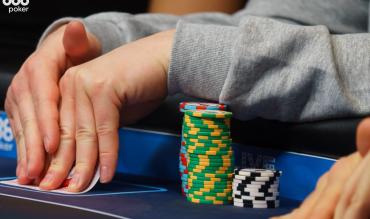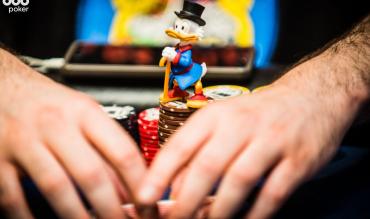Updated on May 29, 2025
The world might be getting more tolerant and inclusive, but plenty of bad guys are still out there. And so, you’ll run into a few at the poker tables from time to time.
Not that you're likely to find the Joker or Thanos lurking in the blinds. Thankfully, card rooms are good at dealing with recognised cheats and rule-breakers, making it hard for the mega-villains to stick around for very long.
Unfortunately, an obsession with winning can bring out the worst in people, and it's not uncommon to see players bend the rules to gain an unfair advantage.
Today, we’ll review the poker term for angle shooting, what it means and how to avoid it.
So, What Precisely Is Angle Shoot Poker?
Angle shooting is doing something to mislead or trick your opponent intentionally, slyly, or dishonestly.
One example is looking down at AA, moving all-in, and then saying something like, "I haven't looked at my cards yet. Let's gamble."

This angle shooter aims to mislead your opponent and trick them into accepting a bet under false pretences. Many poker players are happy to punt to liven up a long session.
Thinking you're blindly going all-in can encourage them to gamble since it would be fair and fun. Thanks to your angle shoot, however, things are far from fair.
Some might call this another form of bluffing akin to using a poker cheat sheet, but most regulars would disagree. As far as poker players are concerned, bluffs use clever betting lines and not a tongue twisted with lies.
The distinction is quite clear— a clever poker bluff demands respect, and an angle shoot does not.
Though angle shooting like this isn’t technically against the rules, it is dirty and sly and not in line with the surprisingly honourable code of etiquette that silently regulates poker games.
What Does Angle Shooting Look Like?
Players can be very creative in their approach to using angle shoot poker.
The most common ways include things like the following:
- Hiding big value chips behind smaller ones to make your stack, hence your poker chips value, look smaller.
- Making a gesture like you are going to call to gauge your opponent’s reaction.
- Intentionally acting out of turn to manipulate your opponent.
- Promising you ‘will show if they fold’ and then not doing so.
- Pretending to accidentally announce a stronger hand than you hold at showdown.
It's worth pointing out that angle shooting refers to a player's physical actions. Slow playing, bluffing, or under-representing your hand are also misleading. But these are not angle shoots since they are an inherent part of poker games.
Who Uses Angle Shooting?
Two main types of people use angle shoot poker:

Poker Muggles:
The first is the poker muggle. New players are often unfamiliar with poker etiquette, which can lead to some accidental angle shooting. They may go to call a bet and then change their mind, unaware that the initial act of ‘forward motion’ might be misleading.
Likewise, they may cover a short stack out of embarrassment or to avoid being picked on by a big stack, unaware that this is against the rules.
Del Boys:
The other kind of angle shooter can be referred to as the Del Boy. A Del Boy is a dishonest, selfish chancer that only cares about winning the pot. Like an old electricity meter with a magnet stuck to the side, his legitimacy is questionable.
Del Boys don't care about etiquette or class and operate in that grey area between respectful poker players and rule-breakers.
While angle shooting is often a Del Boy move, desperation can drive almost anyone to do it. You might be surprised by the kinds of people you see angle shooting a poker hand at the tables.
Dealing with Angle Shooting
Since the difference between an angle shoot and an honest mistake is intent, it can be tricky to deal with an isolated case of angle shooting. After all, it’s tough to know the exact motivation behind someone’s actions. So, perceived angle shoots can easily be honest mistakes, especially if made accidentally by a new player or someone not paying full attention.
This situation presents a challenge for card rooms.
While stamping out cheating is vital in preserving the integrity of the games, punishing players for accidental mistakes can spoil their relationship with poker, cause them to quit, and impact the overall poker ecosystem.

As a result, card rooms apply common sense when they encounter a suspected case of angle shooting. If the player seems new, they may give them the benefit of the doubt and let it slide with a warning.
For repeat offenders, however, punishments can include bans ranging from a hand or two to permanent exclusion.
Common Misconceptions
Many angle shooters will claim their actions are a way of getting a read on their opponent, but there is a big difference between an angle shoot and a legitimate poker read.
A good way to demonstrate the difference is by looking at the way a player handles their chips when facing a bet on the river:
- You are well within your rights to count your chips during a hand, so watching your opponent’s reaction to you doing so is a legitimate way to get a fair read.
- Since your opponent is aware that you have not yet decided, the hand is still in progress, so it is their responsibility to stay as stoic as possible.
- If you can correctly interpret their reactions to your chip shuffling, you’ve made a terrific read; take ‘em down!
However, grabbing a handful of chips and moving them forward towards the betting line to see how your opponent reacts is an angle shoot known as a pump-fake in poker lingo. Your motion leads your opponent to think you have decided, and the hand is over, causing them to give away information they may not have otherwise.
The dishonest intention behind the pump-fake makes it an angle shoot, which is why most casinos now count any ‘forward motion’ as a call.
As far as most poker players are concerned, angle shooting is another form of cheating.
What do you think?
How to Protect Yourself from Angle Shooters
Casinos and players both care about poker’s integrity, so suspected angle shooting is a serious matter. If you suspect something might be amiss, take one of the following two actions:
- Ask the dealer to call the floor manager.
- Or go and have a quiet word with them yourself if you’d rather not make a scene.
When it comes to angle shooting, however, there’s no such thing as ‘Snitches get stitches!’. As far as most serious poker players are concerned, it’s another form of cheating, which means you’re likely to have other players back you up if a player tries something sly.
Angle Shoot Poker Quiz (Scroll down for answers):
1: The main goal of angle shooting in poker is to mislead or trick your opponent.
2: Hiding big chips behind smaller ones to make your stack look smaller is an example of angle shooting.
3: Most poker players accept angle shooting as a fun part of the game.
4: Bluffing is generally considered fair play, while angle shooting is viewed as deceptive and against poker etiquette.
5: You can only angle shoot on the river.
6: Repeat angle shooters may be banned from the card room, sometimes permanently.
7: Bluffing with a weak hand is an example of angle shooting.
8: All angle shooters are new players who don’t understand poker etiquette.
9: Card rooms usually apply common sense when judging whether an action was an honest mistake or angle shooting.
10: Pump-faking is a legitimate way to get a poker read.
Poker Quiz Answers
1: True
2: True
3: False
4: True
5: False
6: True
7: False
8: False
9: True
10: False
See Also


